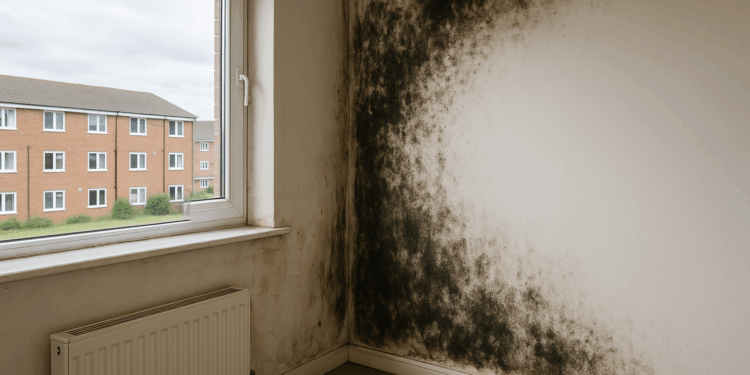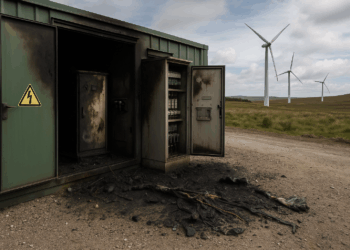Story Highlight
– New regulations require social landlords to address housing issues quickly.
– Awaab’s Law established after tragic death of Awaab Ishak.
– Nearly 23% of social housing tenants face damp or mould.
– Landlords must fix urgent hazards within 24 hours.
– Government launches £1 million fund for tenant engagement.
Full Story
New regulations have been introduced that mandate social housing landlords in England to urgently tackle problems such as damp, mould, and cold conditions, which a recent survey suggests impact nearly a quarter of tenants living in these properties. This legislation, referred to as Awaab’s Law, derives its name from Awaab Ishak, a toddler whose tragic death in December 2020 was attributed to a respiratory illness related to extensive mould exposure in his family’s flat in Rochdale, managed by a housing association. The public outcry following Awaab’s death played a significant role in the swift enactment of this law.
Under the new framework, landlords are now subjected to potential legal repercussions, including court action and compensation directives, should they neglect to rectify reported hazards in a timely manner. If a home cannot be rendered safe within the specified timeframes, landlords are required to provide tenants with alternative accommodation.
As the implementation of these new rules unfolds, a UK-wide survey conducted by Censuswide for the Health Equals campaign reveals distressing findings. The survey, which included responses from 3,982 adults this month, shows that 21% of renters experience issues such as damp, mould, or condensation in their residences, a figure that escalates to 23% among those in social housing.
Advocacy groups are now urging the government to expand these stringent obligations for social landlords to include properties within the private rental sector. Although the government has assured that Awaab’s Law will be integrated into this sector through the forthcoming Renters’ Rights Bill, which is currently pending royal assent, no definitive timeline has been established.
The report from Health Equals highlighted disparities in living conditions, noting that individuals from lower-income households are nearly twice as likely to contend with damp or mould problems compared to their higher-income counterparts — 21% versus 12%. Paul McDonald, chief campaigns officer at Health Equals, emphasised that while Awaab’s Law represents an important step forward, the findings indicate a necessity for additional action.
The rules set to take effect require landlords managing approximately four million social rental homes across England to act swiftly in response to urgent health and safety concerns. The law stipulates that severe hazards reported must be addressed within 24 hours, while landlords are expected to investigate significant damp and mould issues within ten working days. Upon inspection, they are mandated to inform tenants of the findings in writing within three days. For properties housing vulnerable individuals, including young children or those with disabilities, alternative accommodation must be provided if necessary repairs cannot be completed within the stipulated timeframes.
Housing Secretary Steve Reed commented on the importance of these regulations, stating, “Everyone deserves a safe and decent home to live in, and Awaab Ishak is a powerful reminder of how this can sadly be a matter of life or death.” He acknowledged the relentless advocacy of Awaab’s family, asserting that their efforts will serve as a legacy benefiting millions of tenants.
Furthermore, the government has initiated a £1 million fund aimed at fostering better communication and engagement between tenants and landlords, allowing residents more agency in matters that directly influence their living conditions.
A recent report from the Housing Ombudsman indicated a growing discontent regarding inadequate housing conditions. Complaints regarding substandard living environments have surged, increasing over fivefold since five years ago. The Ombudsman identified systemic failings in property maintenance, highlighting that such issues have become increasingly intricate and costly to resolve. Between April 2020 and March 2025, the watchdog investigated 6,380 complaints, dramatically rising from just 1,111 complaints in the previous five-year period.
Issues reported by tenants frequently included serious concerns such as asbestos, electrical and fire safety deficiencies, pest infestations, as well as leaks, dampness, and mould. The heightened dissatisfaction among residents underscores the critical need for effective enforcement of housing regulations that protect all individuals from adverse living conditions.























This is a necessary and overdue step. Enforcing strict timeframes for serious hazards such as damp and mould will help protect tenants from avoidable illness and reduce long term repair costs. Clear responsibilities and funded support for tenant engagement are essential to ensure landlords act promptly. The same standards need to be applied across the private rented sector to prevent a two tier system where health and safety depends on tenure. Compliance monitoring, adequate resourcing for social landlords, and accessible reporting routes for tenants will be key to making these regulations effective.
This is a necessary and overdue step. Clear legal timeframes for addressing serious health hazards like damp and mould will help protect tenants and give landlords unambiguous duties to act quickly. Effective enforcement and adequate resources for social landlords are essential if these rules are to make a real difference. The £1 million engagement fund is a positive start but must be matched by long term investment in repairs and training so issues are fixed properly rather than repeatedly patched. Extending similar protections to the private rental sector should remain a priority to ensure all renters have safe, healthy homes.